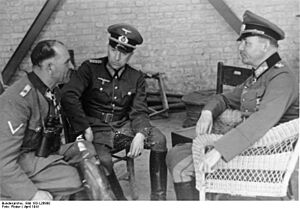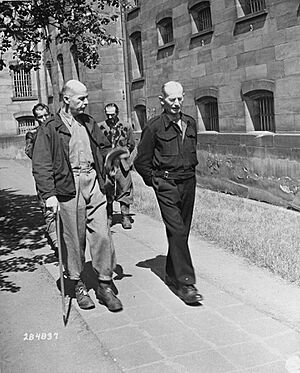Wilhelm List facts for kids
Quick facts for kids
Wilhelm List
|
|
|---|---|

List as General
|
|
| Born | 14 May 1880 Oberkirchberg, Kingdom of Württemberg, German Empire |
| Died | 17 August 1971 (aged 91) Garmisch-Partenkirchen, West Germany |
| Buried |
Munich Waldfriedhof
|
| Allegiance | |
| Years of service | 1898–1942 |
| Rank | Generalfeldmarschall |
| Commands held | 14th Army 12th Army Army Group A |
| Battles/wars |
|
| Awards | Knight's Cross of the Iron Cross |
| Signature | |
Wilhelm List (born May 14, 1880 – died August 17, 1971) was a high-ranking German military leader, known as a Field Marshal, during World War II. After the war, he was found guilty of serious actions during the conflict by a US Army court.
List led the 14th Army during the invasion of Poland. He also commanded the 12th Army in the invasions of France, Yugoslavia, and Greece. In 1941, he was in charge of German forces occupying Greece and Yugoslavia. Later, in July 1942, he became the commander of Army Group A. This group was tasked with a major push towards the Caucasus region in Southern Russia.
After World War II, List was put on trial for his actions. He was found guilty and sentenced to life in prison. However, he was released early due to poor health. He passed away in 1971.
Contents
Early Life and Military Career
Wilhelm List was born in Oberkirchberg, a town in Germany, in 1880. His father was a doctor. List joined the Bavarian Army in 1898. By 1913, he became part of the Bavarian General Staff, which helps plan military operations.
He served as a staff officer during World War I (1914-1918). He spent four years fighting on the front lines as a commander of an infantry unit. After the war, List continued his military career in the German army. In 1938, after Austria joined Germany, List was given the job of bringing the Austrian armed forces into the German army, known as the Wehrmacht.
World War II
In 1939, Wilhelm List led the German 14th Army during the invasion of Poland. His mission was to move his army into southern Poland. The goal was to help surround the Polish army near Warsaw. Although he did not fully complete this specific mission, his forces met other German units near Brest-Litovsk on September 17, 1939. After the fighting in Poland ended, List and his army stayed there as occupying forces.
Invasion of France
In May 1940, during Germany's large attack on France and other nearby countries, List commanded the German 12th Army. This army was part of a larger group that successfully pushed through the Ardennes forest. This breakthrough on May 15, 1940, caused confusion among French forces. It also cut off the British forces from their supplies.
After this successful campaign, List was one of twelve generals promoted to Field Marshal by Hitler in 1940. In early 1941, German troops were gathering on the Eastern Front. They were preparing for Operation Barbarossa, the invasion of the Soviet Union. Before this, Germany wanted to deal with Greece. List was sent to talk with the Bulgarian military leaders. They signed a secret agreement allowing German troops to pass through Bulgaria. On February 28, 1941, List and his 12th Army moved into Bulgaria.
Invasion of Greece and Yugoslavia

On April 6, 1941, the German army launched invasions of both Greece and Yugoslavia. List's 12th Army was very strong, with many armored and infantry divisions. It easily overpowered the defending forces. German troops took control of Belgrade, the capital of Yugoslavia, on April 13. They then occupied Athens, the capital of Greece, on April 27. The main fighting in the Balkans ended when British forces left on April 28. During this campaign, List was involved in ordering actions that led to the deaths of many civilians.
Command in Southern Russia
In early July 1942, List took command of Army Group A. This new group was formed during Germany's summer attack called Case Blue. List's orders were to capture Rostov and then move into the Caucasus region. The goal was to seize the oil-rich areas of Maikop and Grozny.
German forces made good progress for two months. They captured Maikop and almost reached Grozny. However, by the end of August, their advance stopped. This was mainly because Soviet resistance became much stronger. Also, the German army group was running out of fuel and ammunition because their supply lines were too long. To make things worse, many German air force units were moved north in mid-August. They were needed to support another army's push towards Stalingrad.
Hitler was very angry about the loss of speed. He sent a general named Alfred Jodl to visit List on September 7. Jodl was told to tell List to move faster. List explained that he did not have enough soldiers to break through the Soviet defenses to capture Grozny. He believed it was still possible if his army group received more supplies and reinforcements. Jodl agreed with List and told this to Hitler, who became furious. When List suggested moving some stalled units to another part of the front, Hitler removed him from command on September 9. List spent the rest of the war at home and did not return to active duty.
Post-War Trial
After the war ended, List was arrested by the Allies. In 1947, List and eleven of his former officers were charged with serious actions during the war. These charges mainly involved the killing of Serbian hostages in Yugoslavia as a form of punishment. List was tried by a U.S. military court in what was called the Hostages Trial. In February 1948, he was found guilty and sentenced to life in prison.
List was released from prison in December 1952. The official reason was his poor health. However, he lived for another 19 years, passing away on August 17, 1971, at the age of 91.
Images for kids
See also
 In Spanish: Wilhelm List para niños
In Spanish: Wilhelm List para niños



